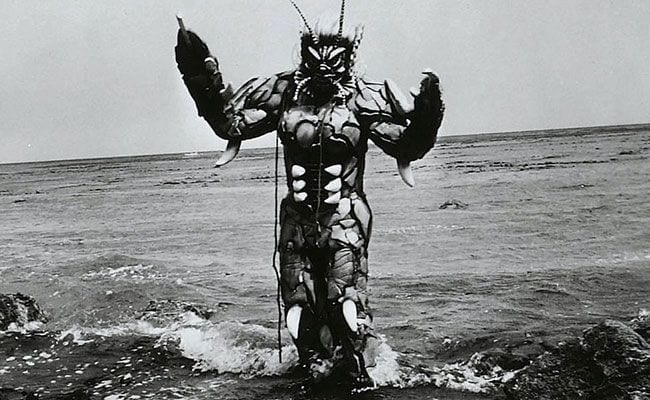
In some ways, serialized television is much easier to analyze. There are narrative arcs, backstory, and, if one is lucky, three-dimensional characters that develop over time. Mystery Science Theater 3000, despite its episodes’ 90-minute length, rarely relied on these elements — the exception being its final three seasons on the SyFy channel, which made some gestures to the ongoing story of both the “Mads” (Pearl [Mary Jo Pehl], Bobo [Kevin Murphy], and Brain Guy [Bill Corbett]) and the reactions of Mike (Michael Nelson), Crow (Bill Corbett), and Servo (Kevin Murphy) trapped on the ship called Satellite of Love.
In the absence of this kind of serialization, Shout! Factorey, in its latest release, does in fact offer a theme for the four included films. Each of the films featured in this collection was produced and distributed by American International Pictures (AIP), whose large collection of B movies are a perfect match for Mystery Science Theater 3000. While Shout! Facotryhad a number of AIP films to choose from (29 of the 197 films skewered on MST3K were produced by AIP), they chose two films by Roger Corman (“The Undead” and “Viking Women and the Sea Serpent”), another favorite target of the series, Bert I. Gordon, and his “War of the Colossal Beast”, and Edward L. Cahn’s “The She-Creature”.
While rights issues make it difficult to release season-length collections for this series, the film choices in this collection underscore Shout! Factory’s ability to make these releases thematically resonant. Aside from sharing the same studio, both “War of the Colossal Beast” and “Viking Women and the Sea Serpent” offer dizzingly bad special effects (“yonder lies the matte painting of the castle of my father”, Servo quips), while “The Undead” and “The She-Creature” both feature women being hypnotized into past-life regressions by unscrupulous men.
The four films are split evenly between Joel Hodgson’s (1988-1993) and Mike Nelson’s (1993-1999) eras, with “War of the Colossal Beast” featuring the famous (and frequently referenced throughout the series) short “Mr. B. Natural”, and “Viking Women and the Sea Serpent” the short “The Home Economics Story”. Offering entries from both the “Joel” and the “Mike” eras of the series makes clear the different styles of both in-theater riffing and the host segments, with the Joel era relying more on absurd/surreal humor (like Joel’s attempts to covert Crow [Trace Beaulieu], Servo, and Gypsy [Jim Mallon] into waffle lovers throughout “Viking Women and the Sea Serpent”), and the Mike era on more cutting and sarcastic humor in-theater and low-level seriality in the host segments (“The She-Creature” features Mike accidentally blowing up Brain Guy’s planet, an action he’ll stand trial for in a later episode). Further, the inclusion of subtitles within these recent releases, as well as the excellent sound transfer, makes it easier not to miss any jokes.
The real gem of the collection, however, is the feature-length extra, It Was a Colossal Teenage Movie Machine: The A.I.P. Story, featuring film historians, artists, and directors (including Roger Corman), which charts the rise and subsequent dissolution (and disillusion) between co-founders James Nicholson and Sam Arkoff. Continuing Shout!’s collaboration with Ballyhoo Films to provide features that further contextualize the B-movies MST3K skewers, the documentary draws a line straight from AIP’s ahead-of-its-time focus on youth, spectacle, and audience desires to the current culture of blockbuster films.
As Stephen King writes in his analysis of horror films, Danse Macabre, AIP rescued the horror genre from “the dungeon” it was sent to during World War Two. Despite the fact that the AIP films were “simple, shot in a hurry, and so amateurish that one can sometimes see the shadow of a boom mike in the shot” (King, pg. 46), it consistently showed a profit by tapping into the youth market. This claim of King’s is verified by the numerous film historians, artists, and directors interviewed in the documentary.
Given the thematic concerns of this collection, the documentary points out another way in which the AIP was ahead of its time: metatextuality. The AIP films re-used phrases, storylines, and actors in various productions while simultaneously calling attention to both the constructed-ness of these films and the previous works of both its stars and the studio. It’s another way in which the AIP films and Mystery Science Theater 3000 work so well together.
Unfortunately, the length and breadth of the included documentary precludes the inclusion of much else in the way of extras within this collection, aside from the original film trailers, and amusing intros by Frank Conniff (i.e., “TV’s Frank”) for both the Joel-era features. The documentary itself, however, is worth it; it offers a thorough analysis of AIP that would be of interest not just to Mystery Science Theater 3000 fans, but film historians and scholars.


![Call for Papers: All Things Reconsidered [MUSIC] May-August 2024](https://www.popmatters.com/wp-content/uploads/2024/04/all-things-reconsidered-call-music-may-2024-720x380.jpg)



